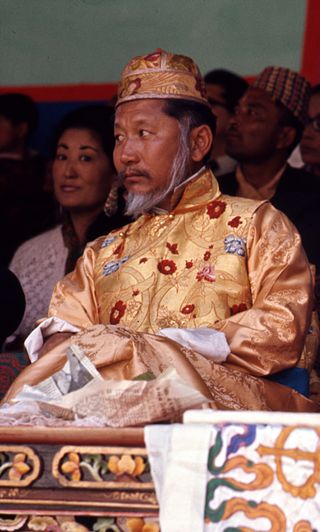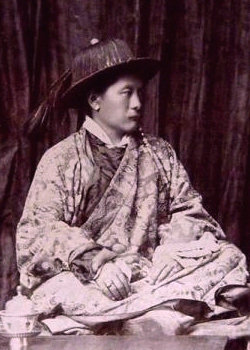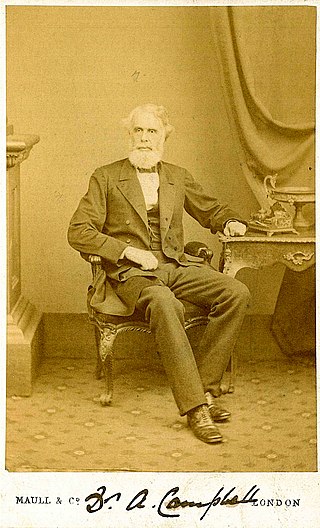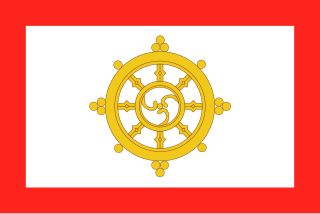
Sikkim is a state in Northeastern India. It borders the Tibet Autonomous Region of China in the north and northeast, Bhutan in the east, Province No. 1 of Nepal in the west and West Bengal in the south. Sikkim is also close to the Siliguri Corridor, which borders Bangladesh. Sikkim is the least populous and second smallest among the Indian states. Situated in the Eastern Himalaya, Sikkim is notable for its biodiversity, including alpine and subtropical climates, as well as being a host to Kangchenjunga, the highest peak in India and third highest on Earth. Sikkim's capital and largest city is Gangtok. Almost 35% of the state is covered by Khangchendzonga National Park – a UNESCO World Heritage Site.

Palden Thondup Namgyal was the 12th and last Chogyal (king) of the Kingdom of Sikkim.

Tashi Namgyal was the ruling Chogyal (King) of Sikkim from 1914 to 1963. He was the son of Thutob Namgyal. He was the first independent king of Sikkim.
Namgyal, a Tibetan deity, has been a personal name in several countries; see :

The history of Sikkim begins with the indigenous Lepcha's contact with early Tibetan settlers. Historically, Sikkim was a sovereign Monarchical State in the eastern Himalayas. Later a protectorate of India followed by a merger with India and official recognition as a state of India. Lepchas were the main inhabitants as well as the Ruler of the land up to 1641. Lepchas are generally considered to be the first people, indigenous to Sikkim also includes Darjeeling.

Darjeeling District is the northernmost district of the state of West Bengal in eastern India in the foothills of the Himalayas. The district is famous for its hill station and Darjeeling tea. Darjeeling is the district headquarters.
Tumlong is a village in the Indian state of Sikkim in northeastern India. It is located in the Mangan sub division of North Sikkim district. it is on the bank of the Dik Chu river, a tributary of the Teesta River.

Yuksom is a historical town in Geyzing subdivision of West Sikkim district in the Northeast Indian state of Sikkim. It was the first capital of Kingdom of Sikkim established in 1642 AD by Phuntsog Namgyal who was the first Chogyal of Sikkim. The coronation site of the first monarch of Sikkim is known as the "Throne of Norbugang". Yuksom is where there is the Norbugang Chorten near the Norbugang throne, the place Namgyal was crowned and several monasteries and a lake. The dynastic rule of the Chogyals lasted for 333 years.

Rabdentse was the second capital of the former Kingdom of Sikkim from 1670 to 1814. The capital city was destroyed by the invading Gurkha army and only the ruins of the palace and the chortens are seen here now. However, the ruins of this city are seen close to Pelling and in West Sikkim district in the Northeastern Indian state of present-day Sikkim; Pemayangtse Monastery is one of the oldest monasteries in Sikkim which is close to the ruins. From the vantage point of this former capital, superb views of the Khanchendzonga ranges can be witnessed. This monument has been declared as of national importance by the Archaeological Survey of India. It was first established in 1670 by the 2nd Chogyal Tensung Namgyal son of the 1st Chogyal Phuntsog Namgyal by shifting from the first capital of Yuksom that was consecrated in 1642.

Phuntsog Namgyal (1604–1670) was the first chogyal (monarch) of Sikkim, now an Indian state. He consecrated in 1642 at the age of 38. Phuntsog was a fifth generation descendant of Khye Bumsa, a 13th-century prince from the Mi-nyak House in Kham in Eastern Tibet. According to legend, Guru Rinpoche, a 9th-century Buddhist saint had foretold the event that a Phuntsog from the east would be the next chogyal of Sikkim. In 1642, three lamas, from the north, west, and south went in search for the chosen person. Near present-day Gangtok, they found a man churning milk. He offered them some refreshments and gave them shelter. So impressed were they by his deeds that they realised that he was a chosen one and immediately crowned him king. The crowning took place Norbughang near Yuksom on a stone slab in a pine covered hill, and he was anointed by sprinkling water from a sacred urn.

A salute state was a princely state under the British Raj that had been granted a gun salute by the British Crown ; i.e., the protocolary privilege for its ruler to be greeted—originally by Royal Navy ships, later also on land—with a number of cannon shots, in graduations of two salutes from three to 21, as recognition of the state's relative status. The gun-salute system of recognition was first instituted during the time of the East India Company in the late 18th century and was continued under direct Crown rule from 1858.

Thutob Namgyal was the ruling chogyal (monarch) of Sikkim between 1874 and 1914. Thutob ascended to the throne succeeding his half-brother Sidkeong Namgyal who died issueless. Differences between the Nepalese settlers and the indigenous population during his reign led to the direct intervention of the British, who were the de facto rulers of the Himalayan nation. The British ruled in favour of the Nepalese much to the discontent of the chogyal, who then retreated to the Chumbi Valley and allied himself with the Tibetans.

Archibald Campbell of the Bengal Medical Service was the first superintendent (1840-1862) of the sanatorium town of Darjeeling in north east India. He also took a great interest in ethnology, economic botany and the study of the region and wrote extensively in the Journal of the Asiatic Society of Bengal under the name of "Dr Campbell" or "Dr A. Campbell" which has led some authors to misidentify his first name as Arthur or even Andrew. Campbell is credited with the introduction of tea cultivation in Darjeeling and for playing a role in the early experiments on the cultivation of Cinchona. Campbell corresponded with numerous naturalists including B.H. Hodgson and Sir Joseph Hooker. The latter travelled around Sikkim with Campbell on an expedition in which the two were held prisoner by Tsugphud Namgyal, the local ruler. This incident led to the British annexation of the Sikkim Terai region.

The History of Darjeeling covers the history of Darjeeling town and its adjoining hill areas belonging to Sikkim, but eventually part of British India so now in the Indian state of West Bengal, which is intertwined with the history of Nepal, Sikkim, Bhutan, Bengal and Great Britain. Part of the state of Sikkim, Darjeeling became part of an important buffer state between Nepal and Bhutan. The British, using the area as a sanitorium, found that the climate provided excellent tea-cultivating conditions and soon began to grow tea on the hills of Darjeeling. Darjeeling tea remains a world-renowned export from Darjeeling.

The Kingdom of Sikkim, officially Dremoshong until the 1800s, was a hereditary monarchy in the Eastern Himalayas which existed from 1642 to 16 May 1975, when it merged with the Republic of India. It was ruled by Chogyals of the Namgyal dynasty.
Tenzing Namgyal was the sixth Chogyal (king) of Sikkim. He succeeded Phuntsog Namgyal II in 1780 and was succeeded himself by Tsugphud Namgyal in 1793.

The Sikkim expedition was an 1888 British military expedition to expel Tibetan forces from Sikkim in present-day northeast India. The roots of the conflict lay in British-Tibetan competition for suzerainty over Sikkim.
Bhim Bahadur Gurung was the third Chief Minister of Sikkim. He held office from 11 May until 24 May 1984, the shortest term in the history of Sikkim.
The Treaty of Tumlong was a March 1861 treaty between Great Britain and the Kingdom of Sikkim in present-day north-east India. Signed by Sir Ashley Eden on behalf of the British and Sikkimese Chogyal, Tsugphud Namgyal, the treaty secured protection for travellers to Sikkim and guaranteed free trade, thereby making the state a de facto British protectorate.

John Claude White was an engineer, photographer, author and civil servant in British India. From 1889 to 1908, White served as the Political Officer in Sikkim, then a British protectorate. As part of his remit, he also managed British India's relations with Tibet and Bhutan.














